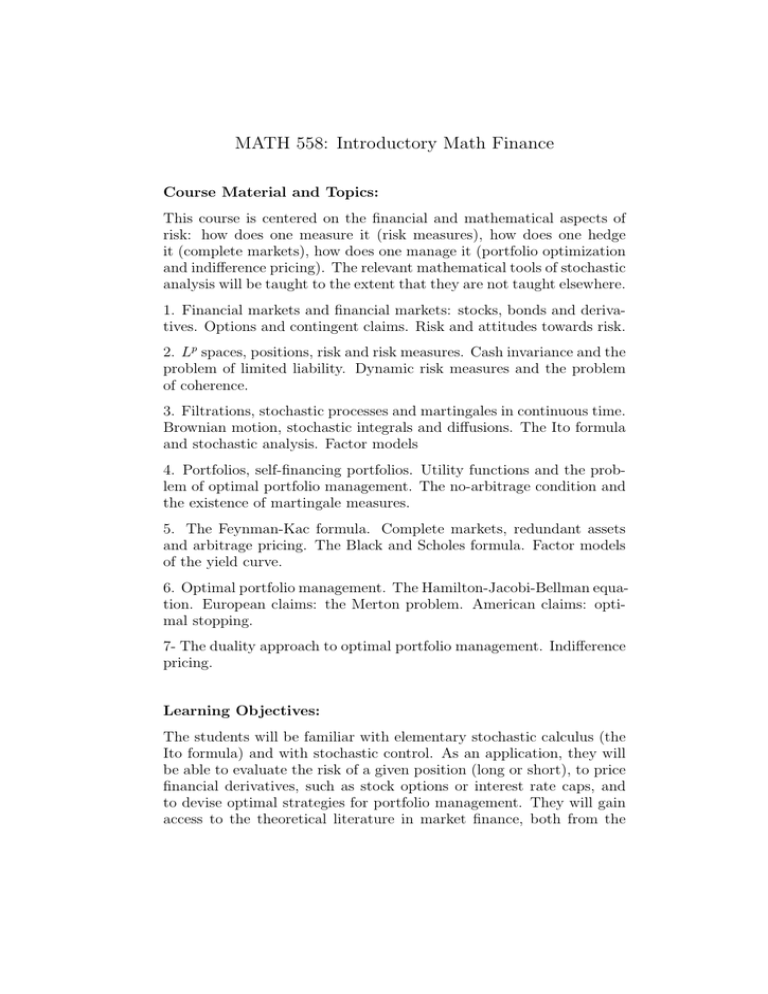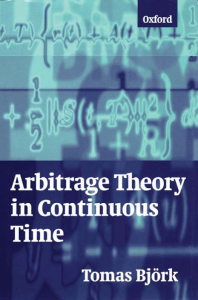MATH 558: Introductory Math Finance
advertisement

MATH 558: Introductory Math Finance Course Material and Topics: This course is centered on the financial and mathematical aspects of risk: how does one measure it (risk measures), how does one hedge it (complete markets), how does one manage it (portfolio optimization and indifference pricing). The relevant mathematical tools of stochastic analysis will be taught to the extent that they are not taught elsewhere. 1. Financial markets and financial markets: stocks, bonds and derivatives. Options and contingent claims. Risk and attitudes towards risk. 2. Lp spaces, positions, risk and risk measures. Cash invariance and the problem of limited liability. Dynamic risk measures and the problem of coherence. 3. Filtrations, stochastic processes and martingales in continuous time. Brownian motion, stochastic integrals and diffusions. The Ito formula and stochastic analysis. Factor models 4. Portfolios, self-financing portfolios. Utility functions and the problem of optimal portfolio management. The no-arbitrage condition and the existence of martingale measures. 5. The Feynman-Kac formula. Complete markets, redundant assets and arbitrage pricing. The Black and Scholes formula. Factor models of the yield curve. 6. Optimal portfolio management. The Hamilton-Jacobi-Bellman equation. European claims: the Merton problem. American claims: optimal stopping. 7- The duality approach to optimal portfolio management. Indifference pricing. Learning Objectives: The students will be familiar with elementary stochastic calculus (the Ito formula) and with stochastic control. As an application, they will be able to evaluate the risk of a given position (long or short), to price financial derivatives, such as stock options or interest rate caps, and to devise optimal strategies for portfolio management. They will gain access to the theoretical literature in market finance, both from the 2 academic and the industrial side, and will be prepared to start some research or to enter an internship. Prerequisites: Measure theory, Lebesgue theory of integration, Lp spaces, Hilbert spaces, the Hahn-Banach separation theorem. Partial differential equations of parabolic type (the heat equation). Convex optimization theory, Lagrange multipliers. Probability spaces, stochastic processes, the Markov property, martingales. Rationale for Course: This is one of the core courses in the Mathematical Finance program. It teaches students the fundamental mathematical techniques and the basic theoretical results (the Black and Scholes formula, the Merton rule). It will be complemented by a second course in the mathematics department, which will teach numerical methods, and by two courses at the Sauder School of business, COMM 671 (Theoretical Finance) and COMM 673 (Advanced Topics in Theoretical Asset Pricing). The latter introduce the students to the basic concepts of AOA (Absence of Arbitrage Opportunities), in a discrete-time framework, and to the CAPM (Capital Asset-Pricing Model). To avoid overlap, this course is set in a continuous-time framework, and will use the optimal control approach rather than the no-arbitrage approach. To take into account recent developments in financial markets, much of the course will focus on risk, how to evaluate it and how to manage it. Textbooks and References: Björk: ”Arbitrage Theory in Continuous Time”, Oxford, second edition, 2003 Föllmer and Schied: ”Stochastic Finance”, de Gruyter, second edition, 2004 Öksendal, ”Stochastic Differential Equations”, sixth edition, Springer, 2006 Shreve, ”Stochastic calculus for finance”, Springer







